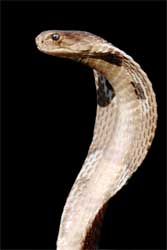|
Cobras are venomous snakes of family Elapidae, of
several genera. (Elapidae also include the taipans, brown snakes,
tiger snakes, fierce snakes, coral snakes, mambas, and sea snakes.)
Cobras generally inhabit tropical and desert regions of Asia and
Africa.
|
|

Look Tough: The cobra's most recognizable feature is its hood, a flap of skin
and muscle behind the head which it can flare, perhaps for the purpose
of making it appear bigger and more threatening to predators. The
cobra's predators include the mongoose and some raptors.

 DANGER POISON!: Elapidae cannot fold their fangs down, as Viperdae can, so the fangs
are generally shorter. They kill their prey, usually small rodents
and birds, by injecting a neurotoxin through their hollow fangs.
The neurotoxin blocks the synaptic communication between the victim's
neurons and muscles, thus stopping movement and control. The King
Cobra notably eats other snakes; it feeds almost entirely on other
snakes, even venomous ones (ophiophagy). The spitting cobra can
also incapacitate larger would-be predators by delivering venom
to their eyes. Cobras come in varying colors from black or dark
brown to yellowish white. The (jet) black cobra found in Pakistan
and North India is considered a sub-species of Indian Cobra (Naja
naja). DANGER POISON!: Elapidae cannot fold their fangs down, as Viperdae can, so the fangs
are generally shorter. They kill their prey, usually small rodents
and birds, by injecting a neurotoxin through their hollow fangs.
The neurotoxin blocks the synaptic communication between the victim's
neurons and muscles, thus stopping movement and control. The King
Cobra notably eats other snakes; it feeds almost entirely on other
snakes, even venomous ones (ophiophagy). The spitting cobra can
also incapacitate larger would-be predators by delivering venom
to their eyes. Cobras come in varying colors from black or dark
brown to yellowish white. The (jet) black cobra found in Pakistan
and North India is considered a sub-species of Indian Cobra (Naja
naja).
What's your name?: "Cobra" is the Portuguese common name for a snake; it
came from late Latin colobra.
When Portuguese navigators arrived to the coasts of Africa and South
Asia in the 16th century, they named the cobras cobra-capelo, which mean hood-snake; from this compound, the name entered Spanish,
French, English, and other European languages.
All text is available under the terms
of the GNU Free Documentation License
|

